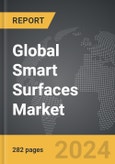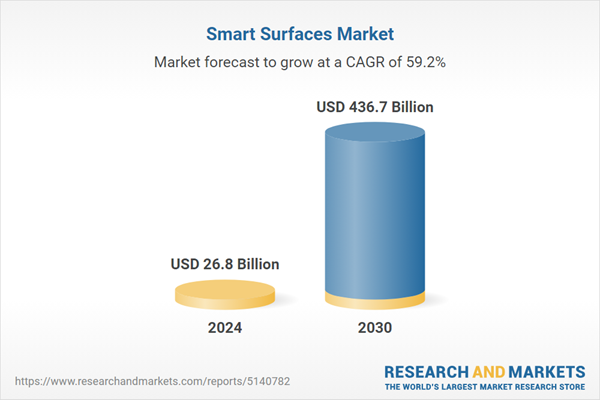The global market for Smart Surfaces was estimated at US$26.8 Billion in 2024 and is projected to reach US$436.7 Billion by 2030, growing at a CAGR of 59.2% from 2024 to 2030. This comprehensive report provides an in-depth analysis of market trends, drivers, and forecasts, helping you make informed business decisions. The report includes the most recent global tariff developments and how they impact the Smart Surfaces market.
Technological advancements have significantly expanded the possibilities for smart surfaces. Developments in nanotechnology and molecular engineering have enabled the creation of surfaces with highly specialized functions at the microscopic level. For instance, superhydrophobic surfaces, inspired by the lotus leaf, repel water and can be used in applications ranging from clothing to solar panels. Similarly, advancements in conductive materials have led to the development of smart surfaces that can function as flexible sensors or interactive displays. Innovations in coating technologies have also made it possible to apply smart surface properties to a wide variety of substrates, including glass, metals, and polymers, thereby broadening the scope of their applications. Research continues to push the boundaries of what smart surfaces can achieve, with ongoing projects exploring self-healing materials, energy-harvesting surfaces, and adaptive camouflage.
The growth in the smart surfaces market is driven by several factors. Increasing demand for high-performance and multifunctional materials in various industries is a primary driver. For instance, the healthcare industry is adopting antimicrobial and easy-to-clean surfaces to improve hygiene and reduce hospital-acquired infections. The consumer electronics sector is leveraging touch-sensitive and flexible display technologies to develop next-generation devices. Additionally, the automotive industry is incorporating smart surfaces for enhanced safety features, such as ice-phobic coatings and adaptive sensors. Advances in material science and nanotechnology are enabling the production of more sophisticated smart surfaces, which are more cost-effective and versatile. The rising emphasis on sustainability is also promoting the development of smart surfaces that can reduce energy consumption or extend the lifespan of products. Furthermore, increased investment in research and development is accelerating innovation and the commercialization of new smart surface technologies. These factors collectively highlight the dynamic and rapidly evolving nature of the smart surfaces market.
Global Smart Surfaces Market - Key Trends & Drivers Summarized
Smart surfaces represent a groundbreaking innovation in material science, encompassing a wide range of applications that respond dynamically to environmental stimuli. These surfaces are engineered to exhibit specific properties or functionalities when exposed to changes in temperature, light, pressure, or chemical environments. Examples include self-cleaning surfaces that use photocatalytic reactions to break down organic matter, antimicrobial surfaces that inhibit the growth of bacteria and viruses, and surfaces that can change color or conductivity in response to external stimuli. These advanced materials are being integrated into various industries, including healthcare, consumer electronics, automotive, and construction, offering enhanced performance and new capabilities.Technological advancements have significantly expanded the possibilities for smart surfaces. Developments in nanotechnology and molecular engineering have enabled the creation of surfaces with highly specialized functions at the microscopic level. For instance, superhydrophobic surfaces, inspired by the lotus leaf, repel water and can be used in applications ranging from clothing to solar panels. Similarly, advancements in conductive materials have led to the development of smart surfaces that can function as flexible sensors or interactive displays. Innovations in coating technologies have also made it possible to apply smart surface properties to a wide variety of substrates, including glass, metals, and polymers, thereby broadening the scope of their applications. Research continues to push the boundaries of what smart surfaces can achieve, with ongoing projects exploring self-healing materials, energy-harvesting surfaces, and adaptive camouflage.
The growth in the smart surfaces market is driven by several factors. Increasing demand for high-performance and multifunctional materials in various industries is a primary driver. For instance, the healthcare industry is adopting antimicrobial and easy-to-clean surfaces to improve hygiene and reduce hospital-acquired infections. The consumer electronics sector is leveraging touch-sensitive and flexible display technologies to develop next-generation devices. Additionally, the automotive industry is incorporating smart surfaces for enhanced safety features, such as ice-phobic coatings and adaptive sensors. Advances in material science and nanotechnology are enabling the production of more sophisticated smart surfaces, which are more cost-effective and versatile. The rising emphasis on sustainability is also promoting the development of smart surfaces that can reduce energy consumption or extend the lifespan of products. Furthermore, increased investment in research and development is accelerating innovation and the commercialization of new smart surface technologies. These factors collectively highlight the dynamic and rapidly evolving nature of the smart surfaces market.
SCOPE OF STUDY:
The report analyzes the Smart Surfaces market in terms of units by the following Segments, and Geographic Regions/Countries:- Segments: Material Type (Self-Cleaning, Self-Healing, Self-Assembling, Other Material Types); Application (Transportation, Medical & Healthcare, Electronics, Construction, Military & Security, Energy, Other Applications)
- Geographic Regions/Countries: World; USA; Canada; Japan; China; Europe; France; Germany; Italy; UK; Rest of Europe; Asia-Pacific; Rest of World.
Key Insights:
- Market Growth: Understand the significant growth trajectory of the Self-Cleaning segment, which is expected to reach US$133.9 Billion by 2030 with a CAGR of a 54.3%. The Self-Healing segment is also set to grow at 58.3% CAGR over the analysis period.
- Regional Analysis: Gain insights into the U.S. market, valued at $7.3 Billion in 2024, and China, forecasted to grow at an impressive 69.0% CAGR to reach $99.3 Billion by 2030. Discover growth trends in other key regions, including Japan, Canada, Germany, and the Asia-Pacific.
Why You Should Buy This Report:
- Detailed Market Analysis: Access a thorough analysis of the Global Smart Surfaces Market, covering all major geographic regions and market segments.
- Competitive Insights: Get an overview of the competitive landscape, including the market presence of major players across different geographies.
- Future Trends and Drivers: Understand the key trends and drivers shaping the future of the Global Smart Surfaces Market.
- Actionable Insights: Benefit from actionable insights that can help you identify new revenue opportunities and make strategic business decisions.
Key Questions Answered:
- How is the Global Smart Surfaces Market expected to evolve by 2030?
- What are the main drivers and restraints affecting the market?
- Which market segments will grow the most over the forecast period?
- How will market shares for different regions and segments change by 2030?
- Who are the leading players in the market, and what are their prospects?
Report Features:
- Comprehensive Market Data: Independent analysis of annual sales and market forecasts in US$ Million from 2024 to 2030.
- In-Depth Regional Analysis: Detailed insights into key markets, including the U.S., China, Japan, Canada, Europe, Asia-Pacific, Latin America, Middle East, and Africa.
- Company Profiles: Coverage of players such as BASF SE, 3M Company, DuPont de Nemours, Inc., Akzo Nobel NV, Evonik Industries AG and more.
- Complimentary Updates: Receive free report updates for one year to keep you informed of the latest market developments.
Some of the 55 companies featured in this Smart Surfaces market report include:
- BASF SE
- 3M Company
- DuPont de Nemours, Inc.
- Akzo Nobel NV
- Evonik Industries AG
- Covestro AG
- Acciona S.A.
- Clariant AG
- FlexEnable Ltd.
- Chasm Advanced Materials, Inc.
- Applied Thin Films, Inc.
- Autonomic Materials, Inc.
- Cowi A/S
- KOSTAL Automotive Electrical Systems
- Miru Smart Technologies
This edition integrates the latest global trade and economic shifts as of June 2025 into comprehensive market analysis. Key updates include:
- Tariff and Trade Impact: Insights into global tariff negotiations across 180+ countries, with analysis of supply chain turbulence, sourcing disruptions, and geographic realignment. Special focus on 2025 as a pivotal year for trade tensions, including updated perspectives on the Trump-era tariffs.
- Adjusted Forecasts and Analytics: Revised global and regional market forecasts through 2030, incorporating tariff effects, economic uncertainty, and structural changes in globalization. Includes segmentation by product, technology, type, material, distribution channel, application, and end-use, with historical analysis since 2015.
- Strategic Market Dynamics: Evaluation of revised market prospects, regional outlooks, and key economic indicators such as population and urbanization trends.
- Innovation & Technology Trends: Latest developments in product and process innovation, emerging technologies, and key industry drivers shaping the competitive landscape.
- Competitive Intelligence: Updated global market share estimates for 2025, competitive positioning of major players (Strong/Active/Niche/Trivial), and refined focus on leading global brands and core players.
- Expert Insight & Commentary: Strategic analysis from economists, trade experts, and domain specialists to contextualize market shifts and identify emerging opportunities.
- Complimentary Update: Buyers receive a free July 2025 update with finalized tariff impacts, new trade agreement effects, revised projections, and expanded country-level coverage.
Table of Contents
I. METHODOLOGYII. EXECUTIVE SUMMARY2. FOCUS ON SELECT PLAYERSIII. MARKET ANALYSISIV. COMPETITION
1. MARKET OVERVIEW
3. MARKET TRENDS & DRIVERS
4. GLOBAL MARKET PERSPECTIVE
UNITED STATES
CANADA
JAPAN
CHINA
EUROPE
FRANCE
GERMANY
ITALY
UNITED KINGDOM
REST OF EUROPE
ASIA-PACIFIC
REST OF WORLD
Companies Mentioned (Partial List)
A selection of companies mentioned in this report includes, but is not limited to:
- BASF SE
- 3M Company
- DuPont de Nemours, Inc.
- Akzo Nobel NV
- Evonik Industries AG
- Covestro AG
- Acciona S.A.
- Clariant AG
- FlexEnable Ltd.
- Chasm Advanced Materials, Inc.
- Applied Thin Films, Inc.
- Autonomic Materials, Inc.
- Cowi A/S
- KOSTAL Automotive Electrical Systems
- Miru Smart Technologies
Table Information
| Report Attribute | Details |
|---|---|
| No. of Pages | 282 |
| Published | July 2025 |
| Forecast Period | 2024 - 2030 |
| Estimated Market Value ( USD | $ 26.8 Billion |
| Forecasted Market Value ( USD | $ 436.7 Billion |
| Compound Annual Growth Rate | 59.2% |
| Regions Covered | Global |








